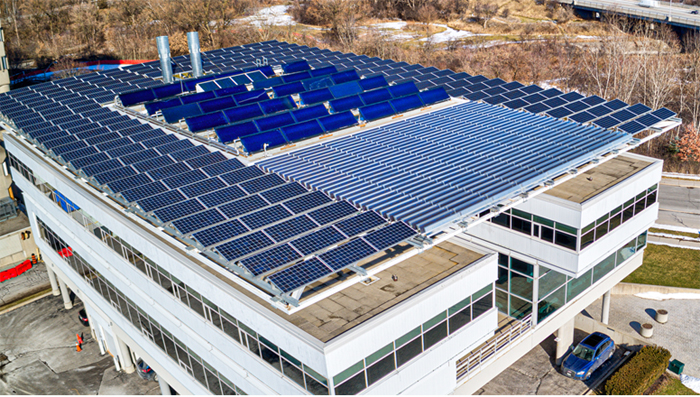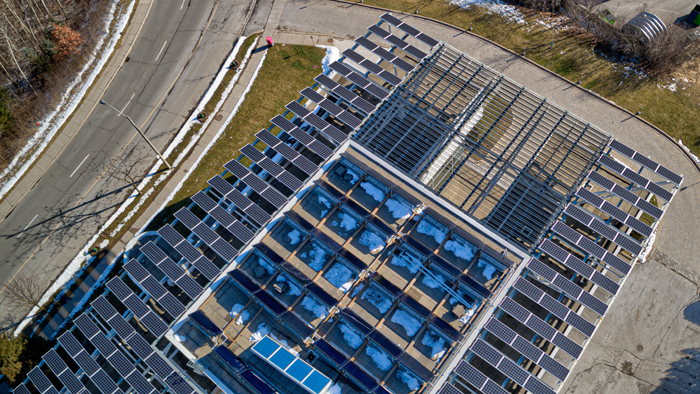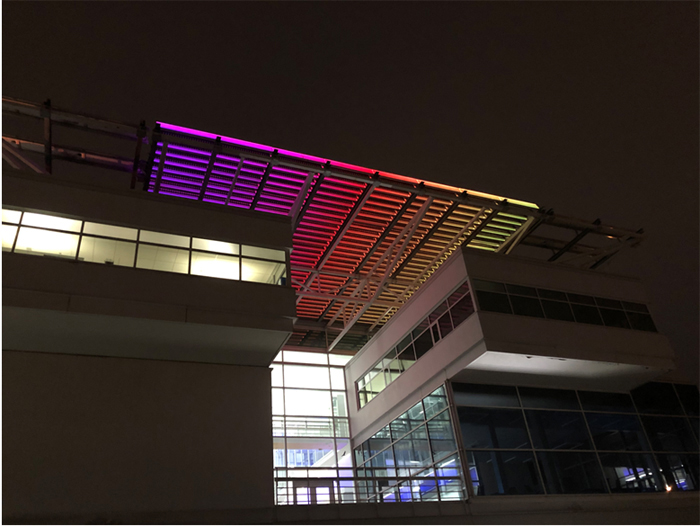|
|

|
  
Features
Update 2020/11/27
Renewables
TORONTO-BASED SOLAR TECHNOLOGY INNOVATOR MORGANSOLAR HAS SOMETHING NEW UNDER THE SUN
By Suzanne Forcese
Over half the world’s population lives in cities. This amounts to almost 80% of our energy use. The expectation that the urban proportion will increase up to two thirds by 2030 brings complex challenges. Reconciling health/wellness concerns of urban inhabitants with sustainable and resilient cities can be resolved by the light management of solar power.
There are however obstacles in traditional solar panels such as space constraints, aesthetics, uneven/undesirable heat distribution, and the creation of health positive benefits in allowing natural sunlight for buildings’ occupants.

OAA (Ontario Association of Architects) Toronto headquarters, recently renovated to achieve zero net carbon in a project that highlights the competing demands for sunlight in high-performance buildings. Photo Courtesy morgansolar
Eliminating problems that are holding solar energy back with reliable and inexpensive solutions is the mantra of Canadian start-up morgansolar. It’s all about resilience, drawing from the team’s banked talents, working with the variable dynamics of demand and recognizing when and how the vision is to be tweaked.
With that winning combination the company has created three revolutionary, market disruptive products: Sun Studio (Intuitive 3D design software for daylight, sunlight, and PV modelling for buildings); Simbax (silicon and cost reducing technology for utility solar panels); and SPOTlight (translucent photovoltaic sun shading technology for buildings).
WATERTODAY had the pleasure of speaking with Nicolas Morgan, Vice President, of morgansolar. The company was co-founded with his brother John Paul Morgan in 2007 out of a desire to see solar become the world’s most affordable and widely used energy source.
The Canadian based developer of light management solutions was conceived when John Paul Morgan returned from a stint—working without electricity, in the Democratic Republic of Congo--managing logistics for Doctors Without Borders.
Having seen the value of solar in Africa, (“after installing a water system, we installed two solar panels which essentially replaced the toil of 20 water mamas carrying water up and down a hill all day, every day,”) John Paul was anxious to support its growth globally.
“John Paul has a unique combination of talents,” Nicolas says of his brother and co-founding partner. “Back then --with his background in the underlying physics of solar design plus his expertise in optical design, we were able to produce what was undeniably the most cost-efficient and advanced concentrated photovoltaic module.”
But something happened on the way to scaling up production to commercialization. The cost of solar energy dropped drastically.
“The cost came down more than anyone in the industry had anticipated. By 2012 we knew we had to pivot. We were just at the crossroads of building our factory and we were seeing the demise of about 100 other companies that had factories. So in our case there was a combination of luck, timing, and our own humility in realizing our focus had to change.”
- 2007: Solar panels were $4 to $5/Watt, and a typical solar panel had a rating of 250-270 Watts. A cost of approximately $1200/panel
- Today: Costs are typically $0.30/Watt, but can go as low as $0.22/Watt. Today’s typical panel costs $105 and produces over 30% more power
In taking stock of assets – financial strength and “the best optical design team in the world” -- Morgan said they capitalized on the fact that they were interested in energy software and product design.
“We created a film that can be integrated into solar panels to boost energy efficiency by 2-3%. That amounts to a cost savings in the millions of dollars for a typical high-rise.”
The Simple Planar Optical Technology (SPOT) is an ultra-thin film made from simple commodity components that internally trap and redirect sunlight to convert it to electricity.
The company’s SPOTlight modules are translucent thereby enabling daylight to come into a building. They are also designed to block direct sunlight. In addition programmable colour LEDs can be easily integrated to turn the panels into a light source and digital display. The advantages of this technology include the ability to capture thermal energy that can be used to heat or cool the interior space while also cutting energy costs.

The pergola as seen from the patio of the OAA , a customized series of translucent optical fins(optimized for building location and orientation using Sun Studio design software) that mitigate solar heat gain and glare while maintaining a view of the sky. The array generates more energy than the conventional PV system.
The second creation is a foundationless tracking system, the Savanna Tracker that moves panels to capture the sun’s rays.(https://youtu.be/RLAIBc0xG90)
This technology allows the panel to follow the sun across the sky thus maximizing energy output. The tracker also has an added benefit for solar farming with its ability to block some light from hitting those crops that require partial shade. Because it features a human height drop-in-place frame that can be serviced manually it eliminates many of the civil works and construction costs making it ideal for use in Africa, India and norther and Indigenous communities in Canada.
morgansolar has become an international business. Interestingly, the Morgan brothers were living in Spain and Chile but chose Toronto as their headquarters.
“There was never any question,” Nicolas told WT. “As a family, Toronto is our base.” He adds that the province’s universities were a big draw as well. “We have some of the best engineers and researchers on our team which has helped us succeed internationally.”
Just on the horizon are some exciting new developments in a new software tool that’s “not quite market ready.”
As for the future, Morgan says, “Energy is a right and we believe that the future is solar. It’s the most abundant and readily available form of energy in the world. Just one hour’s worth of sunlight beaming to earth could power all of humanity for a year – yet half the world still struggles to find reliable sources of energy.
“By transitioning to solar, the economy has the potential to recover post-Covid. Data centres, factories, all businesses that require energy will be able to operate at lower costs thus allowing growth and providing jobs while improving workplace productivity by providing natural light in a comfortable space.”
“We are bringing power to those who need it where they live and work.”
Now that’s an illuminating thought.

LED Illuminated Pergola
suzanne.f@watertoday.ca
|
|
|
Have a question? Give us a call 613-501-0175
All rights reserved 2025 - WATERTODAY - This material may not be reproduced in whole or in part and may not be distributed,
publicly performed, proxy cached or otherwise used, except with express permission.
|
| |